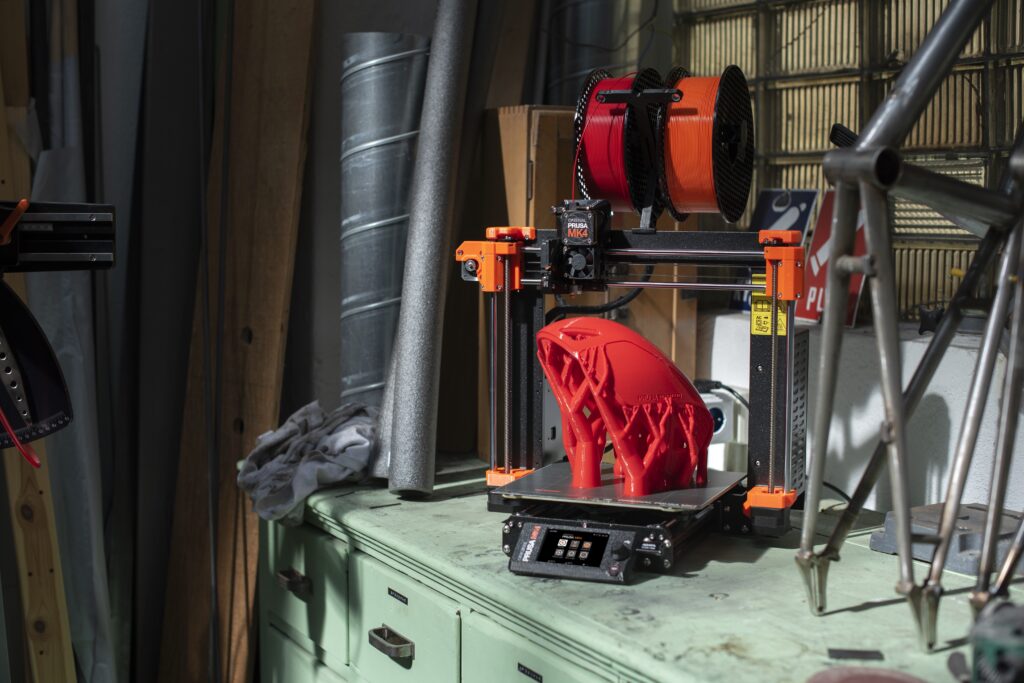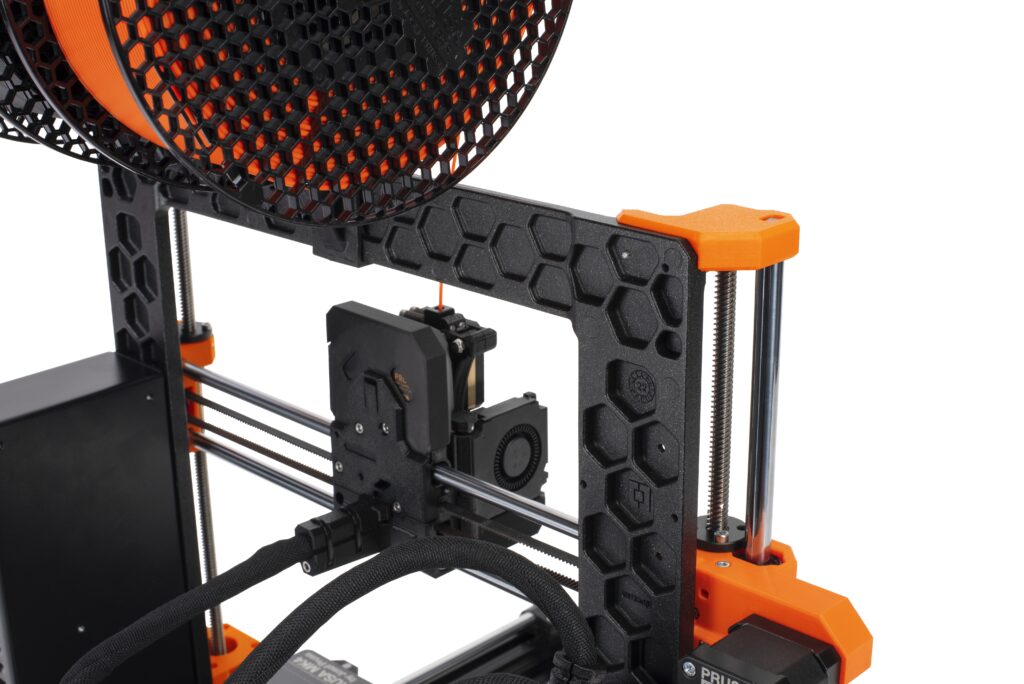The most important 3D printer launch of the year is the launch of the MK4. The MK4 is the upgrade to the MK3, the world´s most popular 3D printer. Developer Prusa Research has sold over 350,000 of them, while other manufacturers have sold over 8 million clones of them. For much of the world, the MK3 in some form or another was the definition of 3D printing. Will the MK4 be the future of desktop 3D printing? Where else will the MK4 be used? Will Prusa Research continue to do well? What about the clone army? And is this a Panda that will eat Bambu? What differentiates this 3D printer from others?
The MK4, Features and Overview
Lets first start by looking at what the MK4 is. It is a $1099 3D printer, with a 32-bit architecture, 250×210×220 mm build volume, easily swappable nozzles and a die-cast sandblasted aluminum frame. The xBuddy, 32-bit STM32-powered mainboard enables many Klipper-like features. Indeed, Prusa says that the company did a Klipper-inspired overhaul that improved speeds and part appearance. A load cell sensor calibrates and levels the build plate, locally or across the entire area, enabling much better first layers.
Quick swap nozzles can be replaced by releasing two plugs and two screws, making for easier nozzle block circumvention and perhaps a lot more nozzle architectures or changeable nozzles. Mesh leveling can be localized to only where parts are to be printed as well. That load cell also means that subsequent calibration is easy. A better LCD screen is nice and there are RGB lights that make it possible to see print progress from afar.
Better stepper motors are said to eliminate the annoying moiré patterns on parts caused by stepper motor resonance. Resonance from vibration in the chassis is further eliminated through a feature called Input Shaper which helps reduce vibration by reducing stepper acceleration challenges as well as sudden stops and starts. Pressure Advance meanwhile reduces under extrusion.
Trinamic 2130 stepper drivers should keep it nice and quiet. Better control over stepper acceleration and deceleration should also improve part looks, speed and perhaps even inter layer bonding. Maximum hot end temperature is 300°C while the heated bed can go to 120°C. Disappointingly there is no real solution for keeping filament dry and in top condition. Better gears should improve filament feeding. There are four thermistors all by Japanese firm Semitec. Inaccurate temperature readings are a source of a lot of chaos in 3D printing land so this is a great place to spend some money. If you think you’re printing at 210°C but the actual nozzle temperature is 228°C then all your support work, googling and adjustments are going to wreak havoc and not lead you to a solution. There’s a smart power saver functionality and support for offline and online working as well as multi material 3D printing.
Will This Be an Important 3D Printer?
The Prusa MK4 will surely be significant. From the specs and improvements, it seems like it could be an amazing machine. Prusa Research machines have incredibly high yield and reliability. The company is the best in the business in QA and quality overall. On the whole it has much better components than most competitors. It also extensively tests its systems and uses them for components. This is an evolutionary 3D printer in a wonderful sense of the word. This is doing exactly what needs to be done to get 3D printing to the next level. Prusa Research also has a wonderful community and incredibly good support. I can already tell you that you should consider this 3D printer, and I haven’t seen it yet.
And this is not something I’d venture saying with any other vendor in the 3D printing space, high end or industrial. Simply put, myself and a lot of other people trust Prusa more than others. The firm is also held solely by its founders with no debt and no antsy VCs on board. This will let it have a long term vision that others can not really match. Given its direct sales ability which has shifted hundreds of thousands of printers so far Prusa Research is a formidable firm. The company is also a leader in filament and sells vat polymerization printers. So yes, this will be an important system and it should be a good one as well.
Will It Be as Important as the MK3?
We don’t know right now. Clone firms are now further along in their development. Many are sure to slavishly copy the MK4. But, companies are busy making higher end systems and ones loaded with many features. Companies have printer with big enclosures and their very own architectures. Creality seems intent on creating an ecosystem with apps, software and scanning to feed its growth while Anet seems intent to expand its lineup. Other firms have essentially thrown in the towel. It is also tough to see how someone would out value engineer the two desktop giants Anet and Creality given their volumes and skill in value engineering. The market is much bigger and new entrants will be more inclined to enter at the higher end or to use own designs.
The MK4 will be the most important 3D printer in the world and is almost sure to sell hundreds of thousands of models. Will it sell millions? This will depend on a hyper competitive landscape and if Anet and Creality continue to work on the MK platform or instead develop their own. It will also depend on a fragmented set of competitors doing the same and competing. It will also depend on just how easy the MK4 is to use day in and day out. More reliability and ease of use will drive adoption. We can’t know now how well it, and software will work in a few years and if this will create millions of new 3D printer users.
Bambu
Then there is the question of Bambu. Bambu Labs made a huge impact with a fully featured 3D printer that is very popular. It is full of smart features and is blazing fast. The company has had to iron out some issues but it is well capitalized and seems to have the wherewithal to continue to improve its machines and conquer new markets. I’m unsure about components on the Bambu machine and how it will hold up long term. But, it is a very good 3D printer. People are sure to similar to Bambu want their own architectures. This will lead to a plethora of designs as well as more everything and the kitchen sink type 3D printers. It will also lead to lots of investment in firmware and software as well as apps. This will mean less relevance for MK4 as an architecture. Also so far a lot of clone army firms have not really had much of a strategy beyond ¨how can we make the cheapest possible i3.¨ Now all of a sudden they need to master software and have a cohesive strategy. Things will get dicey and uneven. But, the Bambu way of positioning itself as a completely new paradigm will sure to be copied. This again will make the MK4 architecture less relevant.
Lineup, Office and Farm
Prusa also has another important printer in its lineup, the CoreXY based $3600 XL. This means that its focus will be divided as well. The XL could push Prusa into Ultimaker S5 territory and into offices and the enterprise. Ultimaker still rules this territory through solid performance and great software. Overall Ultimaker machines have a great reliability and user experience. Average prices have been creeping upward however over time and prices have crept up to over $5000 and $10,000. At the same time the company has been slow to innovate and release new models. Ultimaker is now squarely being targeted by both Bambu and Prusa. So this battle may make the MK4 slightly less relevant inside Prusa Research. From a singularly focused firm it now is spreading its attention. More software through Printables and Prusa Slicer will also mean more organizational complexity and risk for the firm. There could be limits to the current organizational model.
I’m convinced that we´re also seeing the dawn of much larger deployment of print farms of desktop machines in manufacturing and consumer goods. This may also make the XL more prevalent as could a focus on Prusa Farm related developments. On the whole this is a crucial 3D printer. If it works as advertised it may cement Prusa Research ascendancy into the manufacturing world through print farms and towards the enterprise market. But, at the same time a lack of focus and stress on the organizational model will also mean that this may be the machine that was a bridge too far.
Subscribe to Our Email Newsletter
Stay up-to-date on all the latest news from the 3D printing industry and receive information and offers from third party vendors.
You May Also Like
Gorilla Sports GE’s First 3D Printed Titanium Cast
How do you help a gorilla with a broken arm? Sounds like the start of a bad joke a zookeeper might tell, but it’s an actual dilemma recently faced by...
Nylon 3D Printed Parts Made More Functional with Coatings & Colors
Parts 3D printed from polyamide (PA, Nylon) 12 using powder bed fusion (PBF) are a mainstay in the additive manufacturing (AM) industry. While post-finishing processes have improved the porosity of...
$25M to Back Sintavia’s Largest Expansion of Metal 3D Printing Capacity Since 2019
Sintavia, the digital manufacturing company specializing in mission-critical parts for strategic sectors, announced a $25 million investment to increase its production capacity, the largest expansion to its operations since 2019....
Velo3D Initiates Public Offering in a Bid to Strengthen Financial Foundations and Drive Future Growth
Velo3D (NYSE: VLD) has been among a number of publicly traded 3D printing firms that have attempted to weather the current macroeconomic climate. After posting a challenging financial report for 2023,...


































